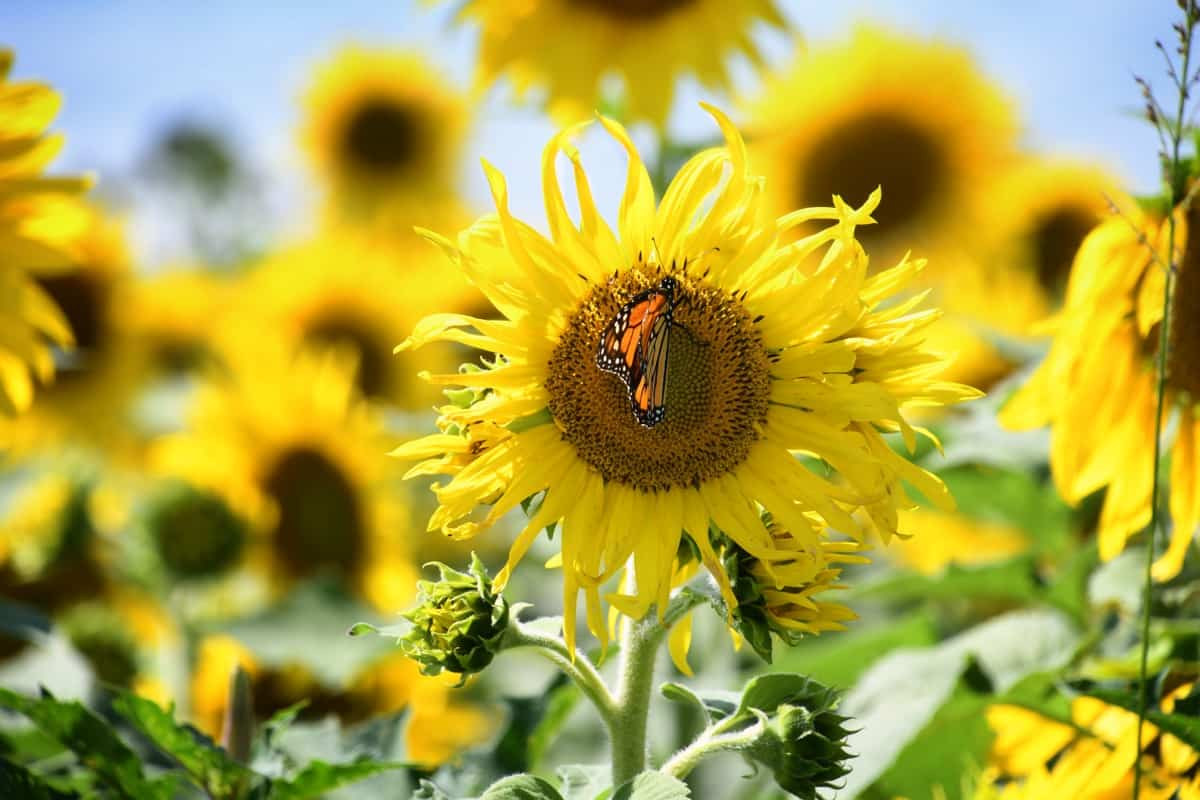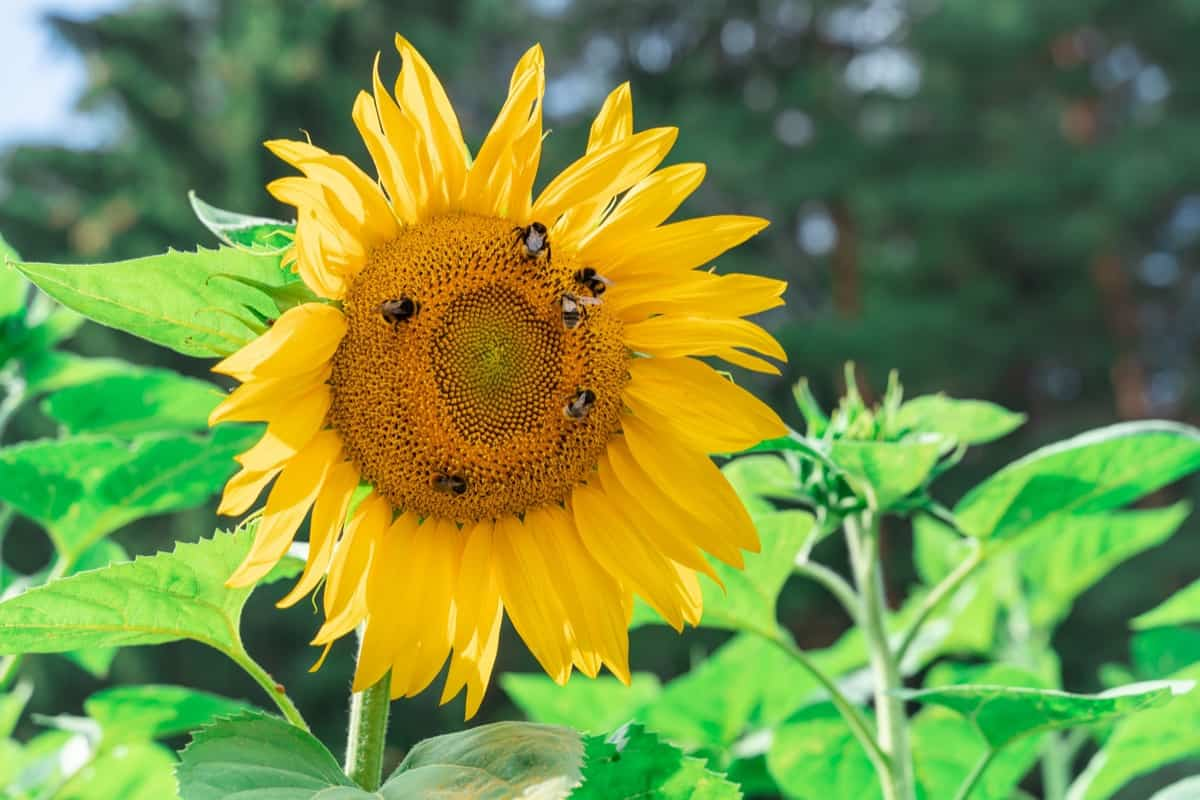The Sunflower, in its gleaming yellow glory, is not just a symbol of adoration, loyalty, and longevity but also a botanical wonder that plays a key role in agriculture and biodiversity. In the complex world of plant reproduction, the question often arises: is sunflower self-pollinated or cross-pollinated? The answer to that is multifaceted.

While sunflowers can self-pollinate to some extent, they predominantly rely on cross-pollination for higher seed yields. This is where the sunflower pollination agent, typically involving insects like bees, comes into play. However, when natural pollinators are lacking, one can resort to hand pollination in sunflower cultivation, which has served as a fruitful hand pollination example in numerous cases.
How to Pollinate Sunflowers
Step-By-Step Guide to Hand Pollinating Sunflower Blooms
Hand pollination is a practical method of ensuring successful pollination when natural agents might not be in adequate numbers. The process is simple, but it demands meticulousness and care. Begin by identifying the male and female parts of the sunflower plant. The male part, or the stamen, contains the pollen, while the female part, the pistil, is where the pollen needs to be transferred.
Gently collect the yellow pollen from the stamen using a small, soft brush or a cotton swab. The next step is to transfer the collected pollen to the pistil delicately. This process mimics what a bee does in nature and results in pollination. Repeat this for all blooms on the plant. Patience is key in hand pollination, and consistency will lead to a successful outcome.
Best Practices for Pollinating Sunflower Plants
To ensure successful sunflower pollination, adopt best practices that improve the odds. The first step is to maintain plant health. Healthy plants attract more pollinators and have better chances of successful pollination. Additionally, grow a variety of sunflowers to promote cross-pollination. When it comes to hand pollination, timing is crucial. The best time to hand pollinate is in the early morning when the flowers have just opened, and the pollen is fresh. Also, using the right tools, like soft brushes or cotton swabs, can significantly improve hand pollination results.
Natural Methods to Encourage Sunflower Pollination
Promoting natural methods of sunflower pollination goes a long way in ensuring a sustainable and productive yield. Start by creating a garden ecosystem that welcomes pollinators. Planting various flowers that bloom at different times can keep your garden buzzing with pollinators throughout the seasons.
In case you missed it: How to Grow and Care for Sunflowers: Planting Instructions

Avoiding the use of pesticides also preserves the health of these beneficial insects. Water sources and habitats like bee hotels can encourage their presence in your garden. Moreover, understanding the predominantly entomophilous or insect-pollinated sunflower pollination type can help create a conducive environment for these agents.
Pollination Techniques for Growing Sunflowers
Various techniques can be employed to facilitate the growth of sunflowers. One can also use other methods like vibrational pollination besides hand pollination. The method uses a compact device that imitates bee vibrations. These vibrations shake the pollen loose, allowing it to fall onto the pistil, thus promoting pollination. Another method is the use of wind pollination, a natural phenomenon where the wind aids in the dispersion of pollen. While sunflowers are not primarily wind-pollinated, this method can support the main insect-driven pollination process.
Ideal Time and Conditions for Sunflower Pollination
The ideal time for sunflower pollination generally falls during the warm summer months, when the sunflower plants are in full bloom, and pollinators are most active. Early mornings are the best time for natural and hand pollination since the pollen is fresh and the temperatures are cooler.
Conditions that favor pollination include warm but not scorching temperatures and calm, dry weather. High humidity or rainfall can hinder pollination by making pollen sticky or washing it away. Therefore, monitoring weather patterns can help optimize the timing of your pollination efforts.
Attracting Pollinators for Sunflower Seed Production
Attracting pollinators is vital for sunflower seed production. Besides planting a diverse range of flowers, consider adding plants that attract bees, butterflies, and other pollinators, such as lavender, marigold, and wildflowers. Provide food and water sources, along with habitats for these beneficial insects. Furthermore, remember that smaller sunflower varieties attract more bees, making them excellent options for boosting pollinator numbers in your garden.
Tools and Supplies for Sunflower Pollination
You will need certain tools for successful sunflower pollination, especially hand pollination. These include soft brushes or cotton swabs for collecting and transferring pollen and a magnifying glass for identifying the plant parts accurately. Gardening gloves might also come in handy to protect your hands, while plant labels can help track which plants have been pollinated. When attracting natural pollinators, consider investing in bee houses and birdbaths.
In case you missed it: How to Start Sunflower Farming in the USA: A Step-By-Step Production Guide

Common Challenges in Sunflower Pollination and How to Overcome Them
Sunflower pollination can be met with a few challenges. These include unfavorable weather conditions, a lack of natural pollinators, and the presence of pests. Overcoming these hurdles involves creating a conducive environment for pollinators, employing hand pollination techniques if needed, and adopting natural pest management strategies.
For instance, introducing beneficial insects or creating barriers can help keep pests at bay. Above all, maintain the health and diversity of your garden, which can ensure resilience against such challenges.
Increasing Sunflower Yield Through Effective Pollination Strategies
Effective pollination strategies are key to enhancing sunflower yield. This involves a blend of natural and manual methods. Diversify your garden with various plants and habitats to attract many pollinators. Utilize hand pollination during the ideal time and conditions, especially without sufficient natural pollinators. Monitor your plants regularly, maintaining their health and promptly addressing any challenges. With these strategies in place, you are well on boosting sunflower yield and reaping a bountiful harvest.
Understanding the Sunflower’s Lifecycle for Successful Pollination
A key step towards successful sunflower pollination lies in understanding the plant’s lifecycle. Knowing when your sunflower plants are in the blooming phase is crucial, as it is during this time that they are ready for pollination. This usually happens around 60-70 days after planting. During the blooming phase, the flowers open up to expose the pollen, which is the best time for natural and hand pollination.
In case you missed it: 1 Acre Sunflower Seed Cultivation Project Report in India: Production Cost and Profit

If you are relying on natural pollinators, remember to plant a variety of sunflowers that bloom at different times to ensure a steady presence of these beneficial insects. If hand pollinating, it is important to be gentle and patient to ensure the successful transfer of pollen without damaging the flower. By understanding and aligning your pollination strategies with the lifecycle of the sunflower, you can ensure maximum effectiveness and higher yield.
Conclusion
Sunflower pollination, whether natural or manual, is a fascinating process integral to the cycle of life in our ecosystems and vital for the success of sunflower cultivation. Sunflowers rely predominantly on cross-pollination, thus necessitating the role of pollination agents such as bees. However, hand pollination is an effective alternative when these natural pollinators are scarce.
The careful implementation of various techniques and best practices, along with creating a pollinator-friendly garden, can significantly increase the yield and success of your sunflower cultivation. By understanding the intricacies of sunflower pollination and adopting sustainable methods, gardeners can ensure a bountiful harvest and contribute positively to the preservation of vital pollinator species.
- Ultimate Guide to Ossabaw Island Hog: Breeding, Raising, Diet, and Care
- Ultimate Guide to Juliana Pig: Raising Facts, Size, Diet, Care, and Lifespan
- Raising Lleyn Sheep: Disadvantages, Price, Uses, Characteristics, and Care
- Ultimate Guide to Meishan Pig: Breed Facts, Breeding, Raising, and Care
- Ultimate Guide to Teacup Pigs: Raising, Diet, Lifespan, Cost, and Care
- Guide to Raising Poll Dorset Sheep: Facts, Profile, Characteristics, Uses, and Care
- Ultimate Guide to Bighorn Sheep: Characteristics, Diet, Lifespan, Breeding, and Lifecycle
- Ultimate Guide to Raising Katahdin Sheep: Farming Facts, Breed Profile, Uses, and Care
- Ultimate Guide to Raising Oreo Cows: Belted Galloways Farming Facts, Profile, Uses, and Care